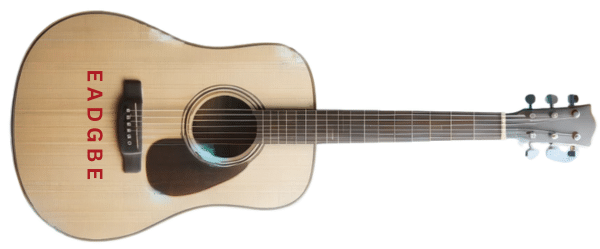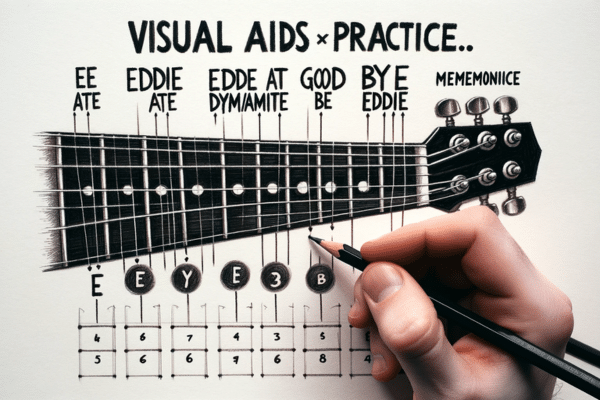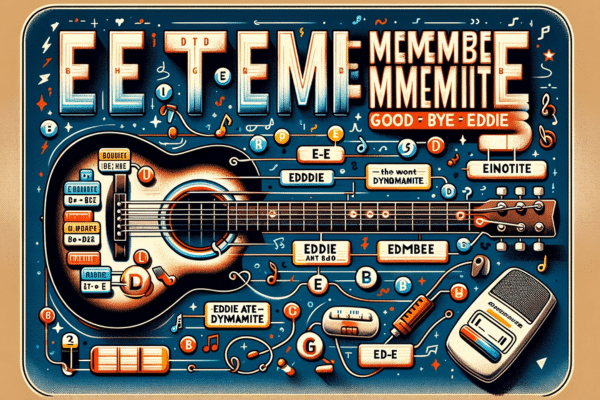Starting your guitar journey can be exhilarating but also filled with tiny challenges, like remembering the names of the guitar strings. “How To Remember Guitar String Names” isn’t just a question; it’ll transform what seems like a mundane memorization task into a fun and engaging experience. With the help of clever mnemonic devices, it’ll make sure you won’t just remember the string names; you’ll know them as well as your favorite songs!
Why is this important, you ask? Well, knowing your string names isn’t just about tuning; it’s the foundation for learning chords, scales, and even creating your own music. The methods we’re about to explore are not only effective but also make the learning process fun. So, grab your guitar, and let’s turn this learning hurdle into a fun-filled musical adventure!
To go to the complete list of mnemonics, click here.
The Short Answer
You can remember guitar string names by using mnemonic devices, simple phrases where each word starts with the same letter as the guitar strings (E, A, D, G, B, E). A popular mnemonic is “Every Awesome Dog Gets Bones Everyday.” These phrases make it easier to memorize the string order, especially for beginners, making guitar learning more efficient and enjoyable.
Key Takeaways

Here are the essential points to remember about learning the string names.
- Personalization Enhances Memory: Tailoring mnemonics to your personal interests or experiences makes them more effective and memorable.
- Consistency is Crucial: Regular practice with your chosen mnemonic, whether during practice sessions or daily guitar routines, solidifies string name recall.
- Adaptability for Different Guitars: The mnemonic method can be adapted for various guitar types, including those with more strings, accommodating diverse musical instruments.
- Engagement Through Creativity: Creating your own mnemonics or modifying existing ones adds a creative element to learning, making it more engaging and less tedious.
- A Stepping Stone for Beginners: Learning string names through mnemonics is a fundamental step for beginners, paving the way for more complex guitar lessons and a deeper understanding of the instrument.
Keep On Reading (Below) To Learn More
Why Mnemonics Are Important
This isn’t just about memorizing six letters. It’s also about forming a relationship with the strings of your instrument! For a beginner, recalling the order of these strings during the heat of practice can be a bit of a head-scratcher. That’s where a handy tool called a mnemonic comes in – it’s a device that helps you remember information in an easy and often humorous way.
In the next section, I’ll help you get familiarized with a mnemonic phrase that has been a saving grace for players in all musical genres.
Mnemonic Devices: The Key to Mastering String Names

First, let’s chat about standard tuning – that’s when your strings are tuned to E-A-D-G-B-E, from the lowest (thickest) string to the highest (thinnest) one. It’s the tuning beginning players typically start with.
Now that you’ve taken the first step in learning guitar, you’ll want to commit the string names to memory. It’s not just about knowing them; it’s about making them second nature. I’m going to introduce you to a tool that musicians have been using for ages: mnemonic devices.
At first glance, ‘Eddie Ate Dynamite, Good Bye Eddie’ might seem like a quirky sentence, but each word represents the first letter of the guitar strings. Imagine Eddie as a character who’s always getting into explosive mishaps. Suddenly, you’ve got a story, a visual, and, more importantly, a way to remember E-A-D-G-B-E!
I particularly like this mnemonic, which appeals to my personality, but you should choose the one that appeals to your nature.
Why Mnemonics Work
Mnemonic devices are the hidden champions in the world of music education. They transform abstract information into something concrete and often entertaining. It’s not just about memorizing; it’s learning in a way that sticks.
Why? Because when you associate the abstract (string names) with the concrete (words or a story), you’re leveraging your brain’s natural inclination for pattern recognition and storytelling.
If ‘Elephants And Donkeys Grow Big Ears’ strikes a chord with you more than Eddie and his dynamite, that’s perfect. The idea is to choose something that resonates with you.
There’s a Mnemonic For You!
But these aren’t the only mnemonics out there. You might come across many variations, each bringing its own flavor of humor or absurdity to the table. Some people prefer ‘Every Acid Dealer Gets Busted Eventually’ for a bit of an edge or ‘Even Average Dogs Get Bones Eventually’ if they’re animal lovers.
Now, that’s going to include tapping into your own interests and preferences as you find or even create the mnemonic that best helps you. These little memory aids are more than tricks; they anchor the string names in your long-term memory through repetition and emotion, be it laughter or just a smirk.
Creative Twists on Classic Mnemonics
The world of mnemonics is wide and wonderfully wacky. Take ‘Eat A Dead Grasshopper Before Everything,’ for example. Sure, it’s a little out there, but it sticks in your memory. That’s what makes it effective!
How about examples, like ‘Every Apple Does Give Bountiful Energy’ or ‘Eat A Darn Good Breakfast Everyday’. Choose something that resonates with you, that makes you smile or even laugh. This emotional connection can help solidify the names in your memory.
So, take these classic tools and twist them into something uniquely yours. Don’t worry too much about sticking to the norm. If ‘Every Amateur Does Get Better Eventually’ sounds more appealing than the standard, then go for it. Personalizing your learning process makes it more enjoyable and memorable.
Letting Your Imagination be Your Guide

There’s a lot of opportunity in these mnemonics to get creative. Do you have a love for a particular animal, food, or activity? Slot it into a mnemonic. ‘Eagles Always Dive Gloriously Before Evening,’ perhaps? The only limit is your imagination.
Repetition is Your Key to Success!
In my opinion, repetition is the mother of all learning. So, once you’ve chosen or created a mnemonic that you like, use it. Practice saying it out loud, write it down, visualize it, and most importantly, apply it every time you pick up your guitar. With each repetition, the string names will become more natural to you.
You can always adjust your approach down the road. Your first attempt doesn’t need to be your last. Just don’t focus too much on perfection; it’s about progress and what works best for you!
Visual Aids and Practice Techniques for Long-Term Retention

You’ve got a whole arsenal of mnemonics at your disposal now, from ‘Eddie Ate Dynamite, Good Bye Eddie’ to variants that might have brought a smile to your face. So, let’s take the next step: using visual aids and practice to move these names from short-term memory tricks to long-term knowledge.
A simple yet effective technique is to draw a guitar neck on paper. Sketch out six strings and write down the corresponding mnemonic from ‘E’ to ‘E.’ This isn’t just about drawing; it’s about engraining the string names into your visual memory with each repetition.
Practice Makes Perfect!
Incorporate string-naming into your daily guitar routine. Maybe you’ll run through the names once every practice session, or perhaps you’ll start each morning by recounting ‘Every Acid Dealer Gets Busted Eventually.’ Choose something that resonates with you and your schedule.
Ditching the Mnemonic!
Finally, aim to transition from mnemonic dependence to instant recall. Over time, you won’t need to mutter ‘Eat All Dead Gophers Before Easter.’ Instead, you’ll know your strings as well as you know the fingers on your fretting hand – intuitively and confidently.
Remember, your first attempt doesn’t need to be your last. I really hope that you keep these tricks up your sleeve and use them as stepping stones on your journey with the guitar. In music, as in all things, consistency is key, and a dash of creativity can work wonders. Soon, those string names will be second nature, and you’ll be ready to focus on crafting melodies that resonate not just with your guitar, but also with your audience.
Popular Mnemonics: The Complete List

Here is a complete list of all ten mnemonic devices in this article to help remember the names of guitar strings in the order E-A-D-G-B-E. Each phrase corresponds to the strings’ names from the lowest (thickest) E string to the highest (thinnest) E string.
- “Eddie Ate Dynamite, Good Bye Eddie”
- “Elephants And Donkeys Grow Big Ears”
- “Every Acid Dealer Gets Busted Eventually”
- “Even Average Dogs Get Bones Eventually”
- “Eat A Dead Grasshopper Before Everything”
- “Eat A Darn Good Breakfast Everyday”
- “Every Amateur Does Get Better Eventually”
- “Eagles Always Dive Gloriously Before Evening”
- “Every Awesome Dog Gets Bones Everyday”
- “Every Apple Does Give Bountiful Energy”
My Early Struggle With Guitar Strings: A Beginner’s Journey
When I first started learning guitar, the strings were like a confusing maze to me. I remember sitting with my guitar, feeling both excited and a bit overwhelmed. The names of the strings just wouldn’t stick in my head, no matter how hard I tried. It was like trying to catch fish with my bare hands – slippery and frustrating!
One day, during a particularly challenging practice session, it hit me: I needed a simple way to remember these string names. That’s when I stumbled upon the idea of using a mnemonic – a phrase where each word starts with the same letter as the guitar strings. So, I came up with “Every Awesome Dog Gets Bones Everyday.” It was quirky, but it painted a vivid picture in my mind. The thickest string was E for ‘Every,’ then A for ‘Awesome,’ and so on down to the thinnest E string.
This little phrase was a game-changer for me. Every time I picked up my guitar, I would repeat “Every Awesome Dog Gets Bones Everyday.” It was like a secret code that unlocked the mystery of the strings. Practice sessions became more fun because I wasn’t constantly struggling to remember the string names.
Looking back, this simple mnemonic was more than just a memory aid. It was a stepping stone that helped me build confidence and familiarity with my guitar. I went from being a puzzled beginner to someone who could quickly identify each string, all thanks to this one mnemonic phrase! This experience taught me that sometimes, the simplest solutions are the most effective, especially when you’re just starting out on your musical journey.
Frequently Asked Questions
Here are some of the questions I get asked about remembering guitar string names.
If your question does not appear here, please put it in the comments, and I will get right back to you with an answer.
Can I Use Mnemonics For Alternate Guitar Tunings?
Absolutely! Mnemonics are versatile and can be adapted for various tunings like Drop D or Open G. Create a phrase that matches the new string order. This method keeps learning fun and efficient, regardless of the tuning you’re using.
Are There Mnemonics For 7-String Or 8-String Guitars?
Yes, you can create mnemonics for guitars with more strings. Simply extend your phrase to include the additional strings. For example, a 7-string guitar tuned to B-E-A-D-G-B-E might use “Big Elephants Always Dance Gracefully, Being Elegant.”
How Can I Practice Remembering String Names Without A Guitar?
Visualize your guitar and mentally practice the mnemonic. You can also draw a guitar neck and label the strings with their names. This mental practice reinforces your memory.
What If Mnemonics Don’t Work For Me?
Mnemonics aren’t for everyone. Try other memory techniques like flashcards or repetition. The key is to find a method that resonates with your learning style.
Can Mnemonics Help With Learning Chords?
Mnemonics mainly aid in memorizing string names. For chords, try associating the shape or sound of the chord with something familiar, or use color-coded diagrams. However, there is an extremely helpful mnemonic for the way chord shapes are laid out on the guitar’s neck called “CAGED.”
How Long Does It Typically Take To Memorize String Names?
It varies per individual. With regular practice and the use of mnemonics, many beginners can comfortably remember the string names within a few days or even immediately!
Can I Create My Own Mnemonics?
Absolutely! Creating your own mnemonic can be more effective because it’s personalized. Use words that are meaningful or humorous to you.
Do Professional Guitarists Use Mnemonics?
Many professional guitarists learned string names using mnemonics during their early stages. Even advanced players find them handy for teaching beginners.
How Can I Teach String Names To Kids?
Kids love fun and engaging methods. Use simple, catchy mnemonics or create a song about the string names. Color-coding strings can also be helpful for visual learning.
Is It Necessary To Know String Names To Play Guitar?
Knowing string names can be crucial for tuning, learning chords, and understanding lessons. It’s a fundamental skill that enhances your overall guitar playing. However, some phenomenal guitar players don’t know the names of the guitar strings because they play totally “by ear.”
Putting It All Together
Learning “How To Remember Guitar String Names” is a big step in your guitar journey. We talked about how mnemonics, like “Every Awesome Dog Gets Bones Everyday,” can make remembering string names easier and more fun. Mnemonics are little phrases that help your brain hold onto information by turning something hard to remember into something simple and catchy.
We also shared a story about my early days of learning guitar. It showed how using a mnemonic helped me get better at remembering the strings, especially during practice sessions. This simple trick made learning the guitar less confusing and more enjoyable. Plus, it even helped during a home recording session when I was super nervous!
Lastly, the FAQ section answered some common questions about learning guitar string names. We learned that mnemonics can be used for different types of guitars and tunings. We also found out that it’s okay if mnemonics don’t work for you; there are other ways to learn, like using flashcards or repetition.
Remember, every guitarist starts somewhere, and learning the string names is a big first step. Using these tips and tricks, you’ll be on your way to becoming a great guitar player! Keep practicing, and don’t forget to have fun with it.

What To Read Next ➡ 20 Guitar Tips For Beginners That You Must Know!
What’s On Your Mind?
Here’s where you get to give me your take on using mnemonic! Don’t hold back if you have something to say or there’s a question you need answered. Jump right into the comments section below, and let it rip!
- What mnemonic did you come up with to remember guitar string names? Share your creative phrases with us!
- Have you ever had a lightbulb moment while learning guitar, like the “Every Awesome Dog Gets Bones Everyday trick?” Tell us about it!
- Which part of this article about How To Remember Guitar String Names was most helpful to you and why?
- Do you have any unique methods or tips for memorizing guitar strings that weren’t mentioned in the article? We’d love to hear them!
- For experienced guitarists: What advice would you give to beginners struggling with learning string names?
- What else is on your mind?
I’m here to help!


